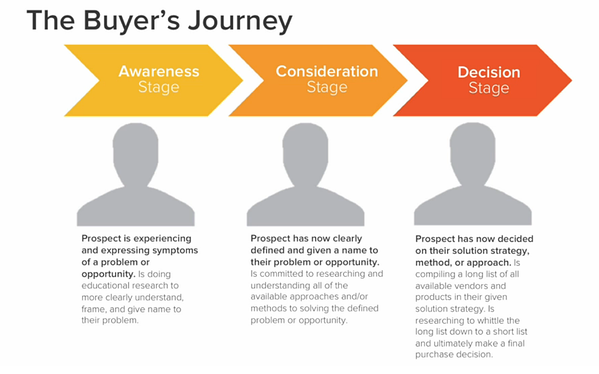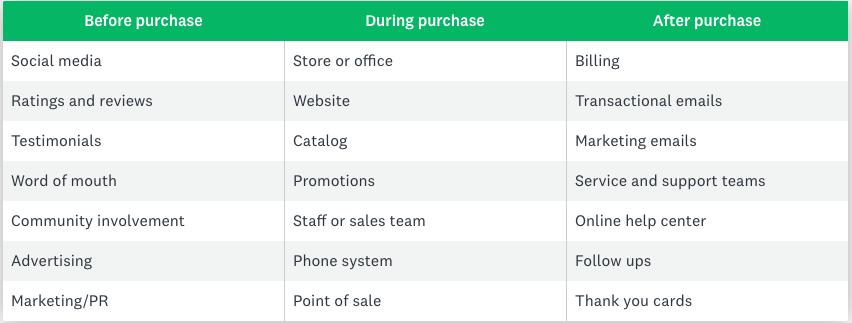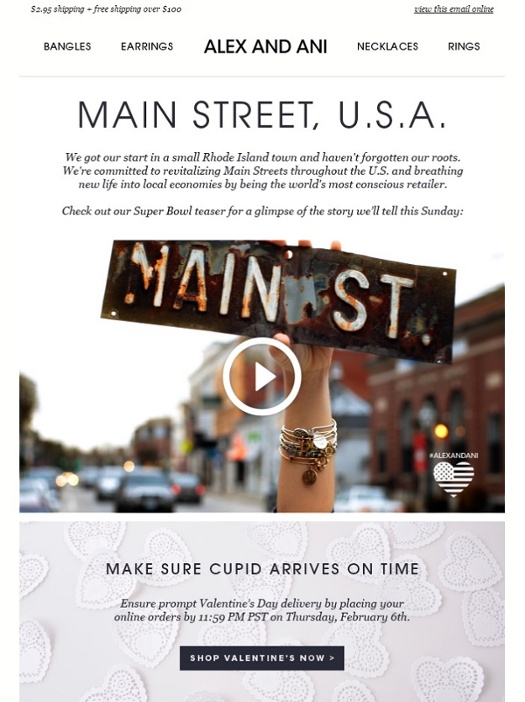By 2021, video is going to make up over 80% of traffic. This leaves businesses without video marketing efforts the arduous task of adapting to a new media for their content marketing strategy.
Thankfully, with the latest video creation tools, organizations are now able to mass-produce videos that can be personalized to the end-user. So, the technology is there, but, organizations will still have to undergo a complete transformation of their end-to-end marketing strategy.
By 2021, video will make up 82% of the internet's traffic Click To TweetVideos will (eventually) be used in every step of the buyer’s journey, from acquisition to retention. Here’s how your organization can benefit from using videos at the different touchpoints of the buyer’s journey:
Quick Refresher: What is the Buyer’s Journey
To sum it up, the buyer’s journey is the active research process a potential buyer goes through leading up to their purchase. The journey consists of buyer becoming aware of a need, considering the different solutions to fulfill that need, and making a decision off of their research.
It’s pretty straightforward, inbound marketers are familiar with the three phases of the journey, and the types of content to create to help guide the buyers. Here’s Hubspot’s Buyer Journey map:

This Buyer’s Journey Map is a great way to have a 30,000-foot view of what a marketing department should be focusing on to acquire and convert new leads successfully.
What isn’t mentioned in the graph is the post-decision (also known as the retention) phase; where you should be actively communicating with your leads (using CRMs or a similar tool), creating a great customer experience that will secure renewals and upsells, improve your Net Promoter Score, and build customer loyalty.
Use Empathy Maps to Relate to Your Buyers
Before you begin creating any type of content, it’s a good practice to build empathy maps to have a better understanding of your users. Here’s what an (extremely simple) empathy map looks like:

Have your team build out several different personas and incorporate market research and data to help understand your client’s pain points. This will help you figure out what kind of content your team should be producing and how to use it at different touchpoints.
Methods Used To Reach Your Audience
Ultimately, you’re looking to touch base with your customers before, during, and after a sale is made. There are a plethora of ways to communicate with your audience. Here are a few:

Using the outlets mentioned above will help get consistent traffic and sales. When businesses establish their voice and tone and have different personas set from empathy maps; then they can map out the content for their buyers’ journey and start thinking on how to use video.
According to Syndacast, 52% of marketing professionals say videos drives the best ROI Click To TweetWhy video? Well, out of all the types of content, videos are guaranteed to get more conversions — significantly more than blog, ebooks, and whitepapers.
Where & How Should You Use Video
Video has already proved itself to be the king of content. The real issue that businesses face is coming up with a video marketing strategy that is uniform, scalable, and consistent.
Previously, it would’ve taken a significant amount of resources to create videos for businesses. Chances are it would’ve been one video produced for every segment with the hopes that the one video would be enough to convert a user.
This is where 1:1 video marketing come in. Mass producing videos that are unique to different segments and, once acquired, tailored to the individual.
Vedia is already using A.I. powered videos to connect with a consumer at every stage of the funnel. Here’s how to use videos in all the different phases.
Personalized Videos in the “Awareness” Phase
For the awareness phase, your team should focus on creating videos that are meant to tell people about your brand’s products and services. These videos should be used in targeted video campaigns and social media ads.
You can utilize all those different types of videos on social, e-mails, and press releases to get more eyes to view your videos.
Types of Videos for the Awareness Phase
- How-To Videos
- Promo Videos
- Research Studies
- Analyst Reports
In this video by Raw Shorts, you’ll get an example of what an awareness stage promo video ad should look like:
As you can see the explainer video template gives a brief explanation of the problem a user is probably facing, then promotes its brand, and provides information on all the services that the company offers.
Videos like the one above can be instantly generated by Vedia. Businesses can create promo video ads from scratch, or, from already existing text-based ads — by simply integrating with an ad generator. We’re able to create video ads through natural language generation, saving our clients time and money.
As for larger brands, awareness-stage videos can include short movies, mini-documentary, and brand films. These typically require an agency or production company to make, so it might not be ideal for a small to medium-sized company.
Here’s a quick example of a brand video by Patagonia:
It’s a short documentary that inspires customers and builds awareness of the values and quality of the items from Patagonia. This video leads their potential customers to a site called WornWear, where customers can shop or donate Patagonia items.
Using Video in the Consideration Phase
The consideration phase is where a prospect has a clear idea of the problem and is analyzing the different means to solve the problems.
At this point, your goal is to differentiate your business from the competition while building a strong relationship with a well-segmented group of potential buyers.
By this point in a buyer’s journey, brands should have the e-mails of the potential buyers. With that data, it is best to send video content from an e-mail tool or CRM (Like MailChimp, Hubspot, or Marketo), through a newsletter.

When sending out videos via newsletters, ads, or CRM’s, it’s extremely important to be clear and informative on how the product offering addresses the needs of the customer. This is why it’s important to have empathy maps set up — as they will help answer questions almost before they’ve thought of it.
If you haven’t done so already at this point, it’s best to invest in retargeting pixels so your brand can remain at the top of customers’ minds. Those impressions throughout the web will allow a customer to feel like they are getting the best out of the bunch.
Types of Videos to Send During Consideration Phase
- Expert Guides
- Product Reviews
- About Us or Culture Videos
Remember, these are the videos that are going to help your brand stand out from competitors. So, give them a bit of life. Here’s a quick example of an About Us video by Mozthat goes showcases its employees and culture.
This video is great for two reasons. It gives potential customers a deeper look at who they are doing business with, and it shows the passion that is put in to build a great product.
These types of videos are ideal in the consideration phase because it humanizes the brand and makes it feel like they are speaking directly to you.
Using Video in the Decision Phase
This is decision time! At this point your potential customer knows about you, your competitors, your products, and is ready to choose a service.
They are ready to sign-up and go from warm lead to a paying client — but they still need just a bit more information before they continue.
Videos in the decision phase should be about establishing that last bit of rapport with a potential client and standing out as a thought leader in the space. Brands can gain that last bit of trust by using success stories and reviews about the company.
Types of Videos for the Decision Phase
- Testimonials
- Case Studies
- Vendor and Product Comparisons
- Product Literature and Demonstrations
Here’s a hilarious testimonial video by the people over at Slack:
This video does a great job of finding a creative way to inform the audience of the problems it solves. They used a hilarious way of addressing the problem that blends well with its explanation of how Slack helped streamline their processes.
Using Video in the Retention Phase
The oft-forgotten retention phase is where you can upsell, recommend new products and services, and thank customers for their trust and loyalty.

Brands show their customers the added value of their products and services by using videos to humanize the brand and build trust. Retention videos can be simple — like sending a video to celebrate a holiday or birthday— or can be informative content like feature updates and any kind of user education.
Types of Videos for the Retention Phase
- Promotions and Loyalty Programs
- Product-Focused Video
- Personalized Updates*
With personalized videos, brands have the ability to use data to create a video that is tailored to a customer’s interests, behaviors, and actions. A personalized approach has proved to be an effective method for repeat business.
The probability of selling to an existing customer is 60%. The probability of selling to a new prospect is about 20% Click To TweetBonus: Use Video to Improve Customer Experience
Adding video content at integral parts of the customer’s journey builds trust between them and a brand. Using data-driven videos, companies are able to leverage the data that has been collected to create personalized videos that are specific to the user.
Here’s the end-result of a video that was created by Vedia with different data points that matched the user’s interests:
As you can see from this video, Vedia was able to use contextual data to create a video that was specific to the individual, incorporating data about an event and market knowledge.
Stats Show That Personalized Video Content Has Improved Customer Experience and Revenue
- Personalized videos can create an emotional connection to a brand, leading to a 306% higher lifetime value
- 86% of buyers are willing to pay more for a great customer experience
- 75% of loyal customers will recommend a brand to friends and family.
- 61% of loyal customers go out of their way to buy from specific brands
A solution like Vedia will have the flexibility to create different types of videos from attraction to retention. Whether it is segmented video ads at the attraction phase or retention videos at the time of renewal.
Start improving your customer experience and start generating revenue with data-driven videos.
How is your company using videos to attract and retain customers?
Are you investing in services like Vedia to help alleviate the stresses that come with traditional video marketing? If possible, let us know how you are incorporating video in your marketing strategy.


4 Comments
Pingback: How to Successfully Launch an Ecommerce Store
Pingback: Are Chatbots Right for Your Business? | Raw Shorts Marketing Blog
Pingback: What is Programmatic Video Advertising And How To Use It | Vedia Blog
Pingback: Everything To Know About Youtube Marketing | Raw Shorts Marketing Blog